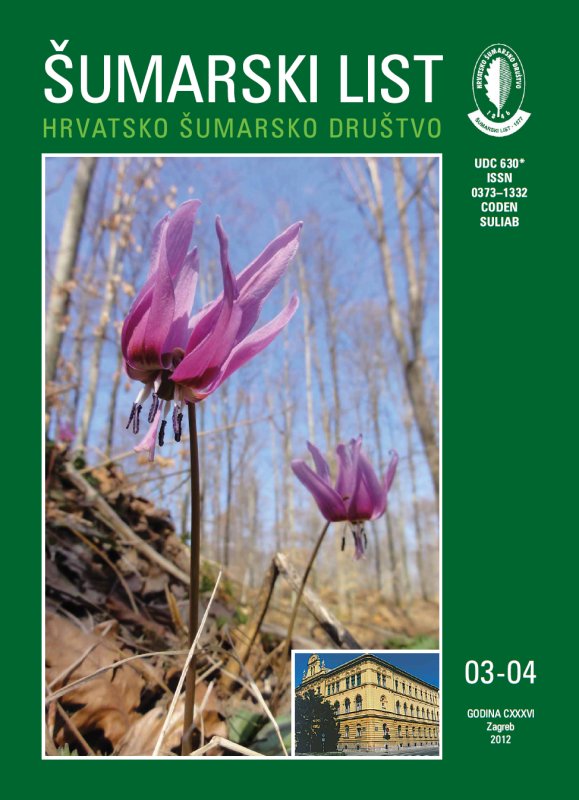
broj: 3-4/2012
pdf (7,00 MB) |
|
||||||||||||||
| RIJEČ UREDNIŠTVA | ||
| Uredništvo | ||
| CROATIAN FORESTRY AT THE CROSSROADS pdf HR EN | 117 | |
| IZVORNI ZNANSTVENI ČLANCI | ||
| Maja Jurc | UDK 630*453 (Phyllonorycter issikii) (001) | |
| The Lime leafminer (Phyllonorycter issikii) in Slovenia pdf HR EN | 119 | |
| Summary: From 2007 to 2008, a study of presence of the lime leafminer (Phyllonorycter issikii) in Slovenia and an attack of different species of the genus Tilia (Tilia cordata, T. platyphyllos, T. tomentosa, T. sp.1, T. sp. 2) in six ecological regions at 22 sites in urban areas was carried out. The aim of the study was to determine the extent of lime leafminer in Slovenia and investigate whether the localities, ecological region, hosts species and years affect the moth population density, the damage to the leaves, and the number and surface of mines in the leaves of different host plants. A total of 918 leaves were analysed; measuring the characteristics of leaves (average leaf area, total number of mines, the average size of mine) was done by scanning, and calculations with the program Digimizer 3.0.0.0., MedCalc Software. Ph. issikii is present throughout Slovenia. Damage to leaves and moth population density was greatest in the Pre-alpine, Pre-panonic and Alpine ecological regions; the largest mines were in the Pre-alpine, Alpine and Pre-panonic ecological regions. Among native limes, the most commonly damaged is T. cordata (91.47%), followed by T. platyphyllos (21.72%), then T. tomentosa (0.41%). By far the greatest damage was appearing on the hybrid lime T. sp.1 (512.5%). Damage to the leaves in the period of investigation was high: 87.8% on average; in 2007, it amounted to 116.3% in 2008 to 66.5%. The surface of mines in the leaves was higher in 2007 year than in 2008 (39.3 mm² compared to 21.4 mm²).
According to the size (surface) of mines, the results showed that there were statistically significant differences between sites in relation to surface of mines on a leaf. The largest surfaces of mines were in the leaves at the locations 19 (Vrt oddelka-Ljubljana), 20 (Pernica) and 21 (Ižakovci); there were significant differences between ecological regions in relation to the surface of mines on a leaf. Larger surfaces of mines were identified in the Pre-alpine region (92.2 mm²) and the Alpine region (59.6 mm²). There are significant differences between tree species in relation to surface of mines on a leaf; greater surfaces of mines were found on the leaves of T. sp.1 (165.3 mm²); finally there are significant differences between years in relation to surface of mines of the leaves. Surface of mines were larger in 2007 compared to 2008. There were significant differences between sites in relation to the number of mines on a leaf; sites 19 (Vrta oddelka – Ljubljana) and 21 (Ižakovci) (5.1 and 3.9) stand out in this regard. There were also significant differences between ecological regions in relation to the number of mines; the Pre-alpine region (2.9) is predominant. There were also significant differences between tree species in relation to the number of mines on a leaf; species 4 (T. sp.1) (5.13) stands out in this regard. Finally, there were significant differences between years in relation to the number of mines on a leaf. This number was higher in 2007. Ph. issikii was discovered in Slovenia in 2006, but we assume that it appeared in Slovenia prior to 2006, considering the distribution of species throughout the country. Due to the relatively large amount damage to the host leaves, we believe that Ph. issikii is a significant pest species of the hosts from the genus Tilia in parks and trees in park-like forests in urban areas. This paper also gives recent data on the range and hosts of the lime leafminer; in Asia, it is indigenous in three countries, while in Europe it has expanded in 20 countries. In natural distribution, its hosts are local species of linden (Tilia spp.); in Europe its hosts are also linden hybrids, as well as exotic species of limes. Key words: Europe Slovenia; Phyllonorycter issikii; Tilia spp. | ||
| Ivan BALENOVIĆ, Ante SELETKOVIĆ, Renata PERNAR, Maša Zorana OSTROGOVIĆ, Anamarija JAZBEC | UDK 630*521+522+531 (001) | |
| Regression models of dbh estimation for photogrammetric maesurement pdf HR EN | 129 | |
| Győző F. HORVÁTH, Dávid SCHÄFFER, Ákos POGÁNY, Dániel TÓTH | UDK 630*451+411 (001) | |
| Spatial distribution of small mammal populations in Drava floodplain forest pdf HR EN | 141 | |
| Tzvetan ZLATANOV, Ivaylo VELICHKOV, Georgi HINKOV, Margarita GEORGIEVA, Olafur EGGERTSSON, Saevar HREIDARSSON, Magdalena ZLATANOVA, Georgi GEORGIEV | UDK 630*561+114 (Castanea sativa Mill.) (001) | |
| Site index curves for European Chestnut (Castanea sativa Mill.) in Belasitsa mountain pdf HR EN | 153 | |
| Bojana KLAŠNJA, Saša ORLOVIĆ, Zoran GALIĆ | UDK 630*232:232.4+238 (001) | |
| Energy potential of poplar plantations in two spacings and two rotations pdf HR EN | 161 | |
| PREGLEDNI ČLANCI | ||
| Igor ANIĆ, Šime MEŠTROVIĆ, Slavko MATIĆ | UDK 630*902 | |
| Important events in the history of forestry in Croatia pdf HR EN | 169 | |


